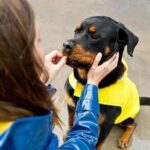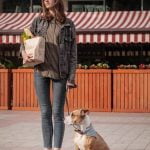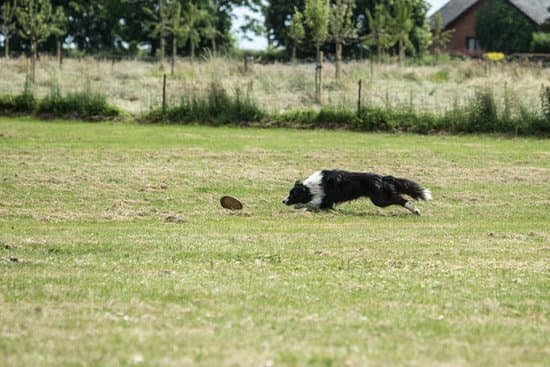Is your dog exhibiting aggressive behavior, specifically growling at children? If so, you may be wondering how to train a dog to not growl at children.
It’s important to understand the root cause of this behavior and identify potential triggers in order to address the issue effectively. In this article, we will explore why dogs may growl at children and provide expert guidance on positive reinforcement training, socializing with kids, supervision and management techniques, building trust and confidence, addressing fear and anxiety, seeking professional help, and offering tips for parents and children.
Many factors can contribute to a dog growling at children, including fear, possessiveness, or past negative experiences. Understanding why your dog may exhibit this behavior will be crucial in finding the right training approach. Positive reinforcement training is a highly effective method for teaching new behaviors to a dog. By using rewards and encouragement, you can help your dog associate positive experiences with children.
Socialization with well-behaved children in a controlled setting is another important aspect of training your dog not to growl at kids. This allows the dog to become accustomed to interacting with children in a positive and safe environment. Additionally, implementing strategies for supervision and management can prevent growling incidents and ensure the safety of both the dog and children.
Positive Reinforcement Training
When it comes to training a dog to not growl at children, positive reinforcement is one of the most effective methods. By using rewards and encouragement, you can teach your dog new behaviors and help them associate positive experiences with children. Here are some steps to take when implementing this type of training:
- Use treats: When your dog behaves calmly around children, reward them with their favorite treats. This will reinforce the idea that good behavior leads to rewards.
- Use praise: In addition to treats, use verbal praise and petting as a form of positive reinforcement. Let your dog know that they are doing a great job when they interact peacefully with children.
- Consistency is key: Make sure all family members and caregivers are on the same page when it comes to using positive reinforcement. Consistency in training will help the dog understand what behaviors are expected of them.
It’s important to keep in mind that every dog is different and may respond differently to various training methods. It’s crucial to be patient and consistent with positive reinforcement training, as it may take time for your dog to learn new behaviors.
Additionally, it’s essential to seek the guidance of a professional dog trainer or behaviorist if you encounter difficulties in training your dog to not growl at children. Professional help can provide personalized advice and support tailored to your specific situation, ensuring the safety and well-being of both the dog and the children they interact with.
Socializing With Children
Introducing a dog to well-behaved, calm children in a controlled setting is an essential step in training a dog to not growl at children. This process allows the dog to become familiar with children in a safe and supervised environment, helping them develop positive associations with kids. Here are some tips for socializing your dog with children:
- Start with one-on-one interactions: Begin by introducing your dog to individual, well-behaved children in a neutral space. Allow the child to approach the dog calmly while maintaining a relaxed demeanor. Use treats and praise to reward the dog for remaining calm and friendly during the interaction.
- Gradually increase exposure: Once your dog has demonstrated good behavior with individual children, gradually increase the level of exposure by introducing them to small groups of children or bringing them to child-friendly environments such as parks or playgrounds. Always supervise these interactions closely and be prepared to intervene if needed.
- Teach children how to interact: Educate children on how to properly interact with dogs, including appropriate ways to pet and play with them. Encourage kids to approach the dog slowly and avoid sudden movements or loud noises that could startle the animal.
By carefully managing and overseeing these socialization experiences, you can help your dog become more comfortable, confident, and relaxed around children, ultimately reducing the likelihood of growling or aggressive behavior. Remember that patience and consistency are key when socializing your dog with kids.
If you’re unsure about how to train a dog to not growl at children despite your best efforts in socializing them, it may be time to seek professional help. A qualified dog trainer or behaviorist can provide personalized guidance and support based on your specific situation. Don’t hesitate to reach out for assistance if you feel that your efforts alone are not producing the desired results.
Supervision and Management
When it comes to training a dog to not growl at children, it is crucial to implement effective supervision and management strategies. This will help prevent potential growling incidents and ensure the safety of both the dog and the children. One important aspect of this process is to recognize and understand the triggers that may lead to growling in dogs. This could include feelings of anxiety, fear, or discomfort around children or certain behaviors exhibited by kids.
Positive reinforcement training is an effective method for addressing growling behavior in dogs. By using rewards and encouragement, you can teach your dog new behaviors and responses when interacting with children. Consistency is key in positive reinforcement training, so be sure to reinforce good behavior consistently to encourage a positive association with children.
Another important aspect of supervising and managing a dog’s behavior around children is socialization. It’s essential to introduce your dog to well-behaved, calm children in a controlled setting. This allows the dog to become more comfortable around kids and reduces the likelihood of growling incidents.
In addition, implementing techniques for building trust and confidence in your dog can also contribute to reducing growling behavior. When a dog trusts its owner and feels confident in various situations, including interactions with children, it is less likely to exhibit fearful or defensive behaviors such as growling.
| Training Method | Effectiveness |
|---|---|
| Positive Reinforcement | Highly effective in teaching new behaviors and creating positive associations |
| Socialization with Children | Important for reducing fear or discomfort around kids |
| Building Trust and Confidence | Can significantly reduce defensive behaviors like growling |
Building Trust and Confidence
One effective way to train a dog to not growl at children is by building trust and confidence. This involves improving the dog’s overall obedience and responsiveness to commands, which can help reduce aggressive behaviors towards children. By establishing a strong bond with the dog, you can create a positive environment where the dog feels secure and less likely to display growling behavior.
Positive reinforcement training is a key aspect of building trust and confidence in dogs. This method involves rewarding the dog for good behavior, such as obeying commands or exhibiting calm behavior around children. Treats, praise, and playtime can be used as rewards to encourage the dog to continue displaying positive behaviors. Training sessions should be kept short and consistent to reinforce desired behaviors effectively.
Another important technique for building trust and confidence in dogs is regular exercise and mental stimulation. Physical activity can help release pent-up energy and reduce stress, leading to a calmer demeanor in the dog. Providing interactive toys or engaging in activities like obedience training, agility exercises, or scent work can also stimulate the dog’s mind and prevent boredom, leading to improved obedience and responsiveness to commands.
It is crucial for dog owners to understand that building trust and confidence takes time and patience. Consistent training, positive reinforcement, regular exercise, and mental stimulation are all essential components of developing a strong bond with the dog while teaching them not to growl at children.
| Techniques for Building Trust | Description |
|---|---|
| Positive Reinforcement Training | Rewarding good behavior with treats, praise, and playtime |
| Regular Exercise | Engaging in physical activities to release energy and reduce stress |
| Mental Stimulation | Providing interactive toys or engaging in obedience training to stimulate the dog’s mind |
Addressing Fear and Anxiety
When it comes to addressing fear and anxiety in dogs, it is crucial to understand the signs that indicate these emotions. Dogs may exhibit various behaviors when feeling fearful or stressed, such as trembling, panting, excessive barking, licking lips, or attempting to hide. In the case of growling at children, it’s important to recognize whether this behavior is rooted in fear or anxiety towards kids.
One way to reduce a dog’s fear and stress towards children is through desensitization and counterconditioning. Desensitization involves gradually exposing the dog to the presence of children from a safe distance and rewarding calm behavior. This process helps the dog build positive associations with children, ultimately reducing their fear or stress response. Counterconditioning, on the other hand, involves changing the dog’s emotional response to children by pairing their presence with something positive, like treats or toys.
In addition to desensitization and counterconditioning, providing a safe space for the dog where they can retreat when feeling anxious can also be beneficial. This could be a designated area in the home where the dog knows they can go if they need some time alone. By recognizing and addressing fear and anxiety in dogs around children, pet owners can work towards creating a more harmonious and safe environment for both their furry friend and their little ones.
Learning how to train a dog to not growl at children involves understanding the root cause of their behavior, using positive reinforcement training techniques, socializing them with well-behaved children under supervision while also addressing any underlying fear and anxiety issues they may have. With patience and consistency, pet owners can help their dogs overcome any negative associations with kids and foster a happier relationship between them.
Seeking Professional Help
If you have tried various training methods and strategies to stop your dog from growling at children without success, it may be time to consider seeking the assistance of a professional dog trainer or behaviorist. While many cases of growling can be addressed with positive reinforcement and socialization, there are instances where the expertise of a professional is needed to properly assess and address the issue.
Assessment and Evaluation
A professional dog trainer or behaviorist can conduct a thorough assessment of your dog’s behavior around children. They will observe the dog’s body language, triggers for growling, and overall temperament to determine the root cause of the behavior. This evaluation will provide valuable insights into the specific issues your dog may be facing and help in developing a tailored training plan.
Customized Training Plan
Based on their assessment, a professional trainer or behaviorist can develop a customized training plan that addresses your dog’s specific needs and challenges. This plan may include targeted desensitization exercises, behavior modification techniques, and specialized commands aimed at changing your dog’s response to children. Additionally, they can equip you with practical strategies for managing growling incidents while working on long-term solutions.
Support and Guidance
Seeking professional help also provides ongoing support and guidance as you work through the training process. A qualified trainer or behaviorist can offer invaluable advice on handling challenging situations, adjusting training methods as needed, and monitoring progress over time. Their expertise can give you peace of mind knowing that you are receiving expert guidance in addressing your dog’s growling behavior towards children.
Remember that seeking professional help does not suggest failure on your part as a pet owner but rather demonstrates your commitment to ensuring a safe and harmonious environment for both your dog and the children in your life. By recognizing when additional support is necessary, you are taking proactive steps towards addressing the issue effectively.
Tips for Parents and Children
In conclusion, training a dog to not growl at children is a complex process that requires patience, consistency, and a deep understanding of canine behavior. It is crucial to first identify the root cause of the growling behavior and potential triggers in order to address them effectively. Positive reinforcement training and socialization with well-behaved children are essential components of this training process.
Supervision and management play a key role in preventing growling incidents and ensuring the safety of both the dog and children. Building trust and confidence through obedience training can also help improve the dog’s overall behavior. Additionally, addressing any fear or anxiety the dog may have is crucial in reducing growling behaviors.
For parents and children, it is important to educate them on how to interact with the dog in a positive and respectful manner. Understanding the signs of fear or stress in dogs, as well as learning how to properly approach and handle a dog, can contribute to a safe and harmonious relationship between the pet and the family.
Ultimately, seeking professional help from a qualified dog trainer or behaviorist may be necessary for more challenging cases. By following these tips and strategies, families can work towards creating a peaceful coexistence between their pets and their little ones.
Frequently Asked Questions
How Do I Get My Dog to Stop Growling at Kids?
To get your dog to stop growling at kids, start by identifying the triggers that cause your dog to react this way. Consider seeking professional help from a dog trainer or behaviorist to address this issue effectively.
How Do I Train My Dog to Not Be Aggressive Towards Kids?
Training your dog to not be aggressive towards kids requires patience, consistency, and positive reinforcement. Start with desensitization exercises where your dog is gradually exposed to children in a controlled environment. Consult with a professional to ensure the safety of both the dog and the children.
How Do You Discipline a Dog That Growls?
When disciplining a dog that growls, it’s important to understand the root cause of the behavior. Avoid punishing or scolding your dog for growling, as this can escalate their aggression. Instead, focus on modifying their behavior through positive reinforcement and training techniques recommended by a professional.

Welcome to the blog! I am a professional dog trainer and have been working with dogs for many years. In this blog, I will be discussing various topics related to dog training, including tips, tricks, and advice. I hope you find this information helpful and informative. Thanks for reading!





